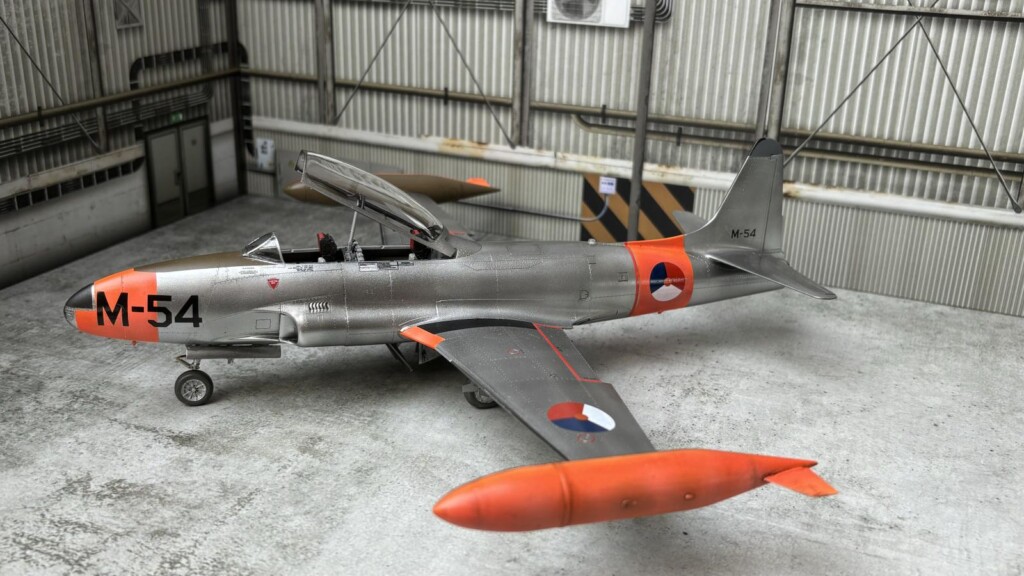1/48 RNLAF T-33A (GWH4819)
Hi all,
Here's my rendition of a T-33A of the Royal Netherlands Airforce (RNLAF).
First a bit of history of the T-bird in Dutch service …
The T-33s became operational as from in 1953 with RNLAF mainly for flight training. The aircraft were delivered within the framework of the MDAP program in which the US supported the NATO countries with the build-up of their armed forces. The first 15 T-33A aircraft were delivered via Denmark in 1952. The remaining 25 aircraft were flown directly from the US.
The T-33s initially flew from Volkel AFB at the "flight school" of the Tactical Air Force Command. The aircraft carried a TR code in the beginning, the M code was applied later in 1959. Soon the aircraft operated also from Eindhoven AFB.
There were also two demo teams flying the T-33; from 1957-1958 with the "Skysharks" and from 1956-1967 also a demo team called "Whisky" which later was renamed in "Whisky Four".
In June 1958, the T-33 aircraft started flying from Woensdrecht AFB. In the early 1960s, cooperation took place with Belgium (including M-42 to M-47, M-59, M-60) regarding advanced and transitional flight training for pilots, using Woensdrecht AFB.
In 1964, 10 additional ex-USAF aircraft were purchased in parts. These were cannibalised though in order to keep the operational fleet in flightworthy.
The joint training operations with the Belgians was discontinued in 1970 as a result of Belgium choosing for the Mirage V and the Netherlands for the NF-5, which created an insurmountable difference in training requirements of both countries.
The T-33 aircraft were subject to a major inspection exercise in 1972 as a result of the fact that quite some aircraft showed severe hairline cracks. It was then decided that further investments in repairs were not useful and the T-33's were gradually withdrawn from service in during 1971-1972.
The total number of flying hours of T-33's in Dutch service is approximately 172.000. During these hours some 600 Dutch and 200 Belgian pilots were trained.
The kit is from GWH and caused no major problems other than those self-inflicted. One exception though is the nose wheel strut. It did not fit into the wheel base and proved to be way too long. Maybe I did something wrong, I don't know. Anyway I solved the problem by making some minor adaptations and shorten the strut.
As there's no dedicated decal set for T-33A in Dutch service, I made use of generic roundels and registration numbers and letters from DutchDecal. Some of the stencils that are RNLAF specific, I made from stencils that I found in my spare parts box and cutting and pasting them in a creative way.
I hope you like it, thanks for watching and happy modeling!














That's a great rendition of a T-Bird. Looks good in Dutch colors.
Thanks Chas! @chasbunch
Lovely build of the venerable T-bird!
Much appreciated, Greg! @gkittinger
Alfred, Realy nice build of a good looking airplane. I really like the paint scheme.
Thank you, Terry! @shoobiz
Nice work, Alfred, and a solid result.
Thank so much, Tom! @tincla
What a great looking T-33, Alfred @alfred
A great addition to your continuously growing RNLAF collection.
She looks beautiful with those orange accents and thanks for sharing the historical background.
Thanks for your nice words, John! @johnb
The collection surely grows.
Nice work, Alfred. Great job on the paint.
Thanks so much, John! @j-healy
Excellent T-33, Alfred!
Looks great in Dutch livery!
Thanks Spiros, I did my best. Glad you like it!
Great-looking T-Bird, Alfred (@alfred). The natural metal finish looks very nice, as does the subtle shading on the high-vis paint. I am surprised that there aren't any decals for a Dutch T-Bird. Background hanger is very effective for the photos. Well done.
Thank you, George! @gblair
Yes, the orange day-glo paint used to fade very quickly. I tried to replicate that effect on a few areas by mixing some white with the paint. Very well observed by you!
With regards to the decals they have been available as a limited edition, but now out of stock for a very long time already.
very eye catching scheme. Well done Alfred!
Thank you, David! @dbutlr